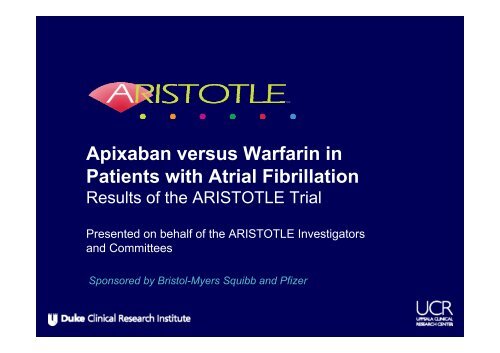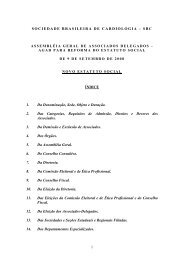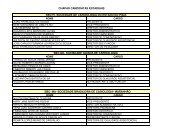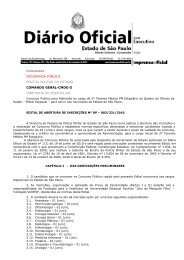Apixaban versus Warfarin in Patients with Atrial Fibrillation
Apixaban versus Warfarin in Patients with Atrial Fibrillation
Apixaban versus Warfarin in Patients with Atrial Fibrillation
You also want an ePaper? Increase the reach of your titles
YUMPU automatically turns print PDFs into web optimized ePapers that Google loves.
<strong>Apixaban</strong> <strong>versus</strong> <strong>Warfar<strong>in</strong></strong> <strong>in</strong><strong>Patients</strong> <strong>with</strong> <strong>Atrial</strong> <strong>Fibrillation</strong>Results of the ARISTOTLE TrialPresented on behalf of the ARISTOTLE Investigatorsand CommitteesSponsored by Bristol-Myers Squibb and Pfizer
Background• <strong>Warfar<strong>in</strong></strong> is very effective at prevent<strong>in</strong>g stroke <strong>in</strong> patients<strong>with</strong> atrial fibrillation.• <strong>Warfar<strong>in</strong></strong> has several limitations, <strong>in</strong>clud<strong>in</strong>g drug and food<strong>in</strong>teractions, a narrow therapeutic range, need foranticoagulation monitor<strong>in</strong>g, and bleed<strong>in</strong>g.• <strong>Apixaban</strong> is a novel oral factor Xa <strong>in</strong>hibitor <strong>with</strong> rapidabsorption, a half life of about 12 hours, and 25% renalelim<strong>in</strong>ation.• <strong>Apixaban</strong> has been shown to reduce stroke and systemicembolism by 55% compared <strong>with</strong> aspir<strong>in</strong> <strong>in</strong> patients <strong>with</strong>atrial fibrillation and not suitable for warfar<strong>in</strong>.
<strong>Atrial</strong> <strong>Fibrillation</strong> <strong>with</strong> at Least OneAdditional Risk Factor for StrokeInclusion risk factors•Age≥ 75 years•Prior stroke, TIA, or SE•HF or LVEF ≤ 40%•Diabetes mellitus•HypertensionRandomizedouble bl<strong>in</strong>d,double dummy(n = 18,201)Major exclusion criteria•Mechanical prosthetic valve•Severe renal <strong>in</strong>sufficiency•Need for aspir<strong>in</strong> plusthienopyrid<strong>in</strong>e<strong>Apixaban</strong> 5 mg oral twice daily(2.5 mg BID <strong>in</strong> selected patients)<strong>Warfar<strong>in</strong></strong>(target INR 2-3) 2<strong>Warfar<strong>in</strong></strong>/warfar<strong>in</strong> placebo adjusted by INR/sham INRbased on encrypted po<strong>in</strong>t-of-care test<strong>in</strong>g devicePrimary outcome: stroke or systemic embolismHierarchical test<strong>in</strong>g: non-<strong>in</strong>feriority for primary outcome, superiority forprimary outcome, major bleed<strong>in</strong>g, death
Enrollment18,201 patients, 1034 sites, 39 countriesNorway: 90Poland: 314Sweden: 217F<strong>in</strong>land: 26Hungary: 455Canada:1057United States:3433Mexico:609Colombia: 111Peru: 213Denmark: 339U.K.: 434Netherlands: 309Belgium: 194Germany: 854France: 35Spa<strong>in</strong>: 230Czech Rep: 165Austria: 34Italy: 178Brazil: 700 Israel: 344Romania: 274Ukra<strong>in</strong>e: 956Turkey: 6Russia: 1800India:601Malaysia: 126S<strong>in</strong>gapore: 40Ch<strong>in</strong>a: 843Japan: 336South Korea: 310Taiwan: 57Hong Kong: 76Philipp<strong>in</strong>es: 205Chile: 258South Africa: 89Australia: 322Argent<strong>in</strong>a: 1561
ObjectivesPrimary objective•To determ<strong>in</strong>e whether apixaban is non-<strong>in</strong>ferior to warfar<strong>in</strong> atreduc<strong>in</strong>g stroke (ischemic or hemorrhagic) or systemic embolism<strong>in</strong> patients <strong>with</strong> atrial fibrillation and at least one additional riskfactor for stroke.Primary safety outcome•Major bleed<strong>in</strong>g accord<strong>in</strong>g to the International Society ofThrombosis and Hemostasis (ISTH) def<strong>in</strong>ition.
Objectives and StatisticsTo control the overall type I error, a pre-specifiedhierarchical sequential test<strong>in</strong>g was performed.1.The primary outcome (stroke or systemic embolism) for non<strong>in</strong>feriority(upper limit of 95% CI < 1.38 and upper limit of 99% CI< 1.44)2.If met, then the primary outcome was tested for superiority3.If met, then major bleed<strong>in</strong>g was tested for superiority4.If met, then all-cause mortality was tested for superiority
Methods• The primary analyses were performed us<strong>in</strong>g Cox proportionalhazards model<strong>in</strong>g <strong>with</strong> warfar<strong>in</strong>-naïve status and world region(North America, South America, Europe, Asia/Pacific) asstrata.• Efficacy analyses <strong>in</strong>cluded all randomized patients (<strong>in</strong>tentionto-treat)and <strong>in</strong>cluded all events from randomization until theefficacy cutoff date (predef<strong>in</strong>ed as January 30, 2011).• Bleed<strong>in</strong>g analyses were “on treatment” <strong>in</strong>clud<strong>in</strong>g allrandomized patients who received at least 1 dose of studydrug and all events from <strong>in</strong>itial receipt until 2 days after the lastdose of study drug.
<strong>Apixaban</strong> and <strong>Warfar<strong>in</strong></strong> Dos<strong>in</strong>g• <strong>Apixaban</strong> (or match<strong>in</strong>g placebo) was dosed at 5 mg twice daily,or 2.5 mg twice daily for a subset of patients <strong>with</strong> 2 or more ofthe follow<strong>in</strong>g criteria: age ≥ 80 years, body weight ≤ 60 kg,serum creat<strong>in</strong><strong>in</strong>e ≥ 1.5 mg/dL (133 µmol/L).• <strong>Warfar<strong>in</strong></strong> (or match<strong>in</strong>g placebo) was dosed guided by bl<strong>in</strong>dedencrypted INR po<strong>in</strong>t-of-care device, <strong>with</strong> target INR of 2.0–3.0.
Basel<strong>in</strong>e CharacteristicsCharacteristic<strong>Apixaban</strong>(n=9120)<strong>Warfar<strong>in</strong></strong>(n=9081)Age, years, median (25 th , 75 th %ile) 70 (63, 76) 70 (63, 76)Women, % 35 35Region, %North America 25 25Lat<strong>in</strong> America 19 19Europe 40 40Asia/Pacific 16 16<strong>Warfar<strong>in</strong></strong> naïve, % 43 43CHADS score, mean (+/- SD) 2.1 (+/- 1.1) 2.1 (+/- 1.1)1, % 34 342, % 36 36≥ 3, % 30 30
Basel<strong>in</strong>e CharacteristicsCharacteristic<strong>Apixaban</strong>(n=9120)<strong>Warfar<strong>in</strong></strong>(n=9081)Qualify<strong>in</strong>g risk factors, %Age ≥75 yrs 31 31Prior stroke, TIA, or SE 19 20Heart failure or reduced LV EF 35 36Diabetes 25 25Hypertension 87 88Renal function (Cl Cr ml/m<strong>in</strong>), %Normal (>80) 41 41Mild impairment (>50 – 80) 42 42Moderate impairment (>30 – 50) 15 15Severe impairment (≤ 30) 1.5 1.5
Trial Metrics• <strong>Patients</strong> enrolled from December 2006 to April 2010• Median duration of follow-up 1.8 years• Drug discont<strong>in</strong>uation <strong>in</strong> 25.3% of apixaban and 27.5% ofwarfar<strong>in</strong> patients (p=0.001)• Vital status at the end of the trial was miss<strong>in</strong>g <strong>in</strong> 380 (2.1%)patients– Withdrawal of consent <strong>in</strong> 199 patients– Loss to follow-up <strong>in</strong> 69 patients• Median (and mean) times <strong>in</strong> therapeutic INR range amongwarfar<strong>in</strong>- treated patients were 66.0 (and 62.2)%.*Rosendaal FR et al. Throb Haemost 1993;69:236–39.
Primary OutcomeStroke (ischemic or hemorrhagic) or systemic embolismP (non-<strong>in</strong>feriority)
Efficacy OutcomesOutcome<strong>Apixaban</strong>(N=9120)Event Rate(%/yr)<strong>Warfar<strong>in</strong></strong>(N=9081)Event Rate(%/yr)HR (95% CI)PValueStroke or systemic embolism* 1.27 1.60 0.79 (0.66, 0.95) 0.011Stroke 1.19 1.51 0.79 (0.65, 0.95) 0.012Ischemic or uncerta<strong>in</strong> 0.97 1.05 0.92 (0.74, 1.13) 0.42Hemorrhagic 0.24 0.47 0.51 (0.35, 0.75)
Major Bleed<strong>in</strong>gISTH def<strong>in</strong>ition31% RRR<strong>Apixaban</strong> 327 patients, 2.13% per year<strong>Warfar<strong>in</strong></strong> 462 patients, 3.09% per yearHR 0.69 (95% CI, 0.60–0.80); P
Bleed<strong>in</strong>g OutcomesOutcome<strong>Apixaban</strong>(N=9088)Event Rate(%/yr)<strong>Warfar<strong>in</strong></strong>(N=9052)Event Rate(%/yr)HR (95% CI)P ValuePrimary safety outcome:ISTH major bleed<strong>in</strong>g*2.13 3.09 0.69 (0.60, 0.80)
Subgroups for Stroke and Systemic Embolism(1 of 2)
Subgroups for Stroke and Systemic Embolism(2 of 2)
Subgroups for Major Bleed<strong>in</strong>g(1 of 2)
Subgroups for Major Bleed<strong>in</strong>g(2 of 2)
Adverse Events and Liver Function TestsN (%)<strong>Apixaban</strong>(N=9088)<strong>Warfar<strong>in</strong></strong>(N=9052)Total patients <strong>with</strong> an adverse event 7406 (81.5) 7521 (83.1)Total patients <strong>with</strong> a serious adverse event 3182 (35.0) 3302 (36.5)Serious adverse events reported <strong>in</strong> ≥ 1% ofpatients <strong>in</strong> either treatment group<strong>Atrial</strong> fibrillation 301 (3.3) 287 (3.2)Pneumonia 202 (2.2) 231 (2.6)Discont<strong>in</strong>uations due to an adverse event 688 (7.6) 758 (8.4)ALT or AST > 3X ULN and total bilirub<strong>in</strong> > 2X ULN 30/ 8788 (0.3) 31/ 8756 (0.4)ALT elevation> 3X ULN 100/ 8790 (1.1) 89/ 8759 (1.0)> 5X ULN 45/ 8790 (0.5) 47/ 8759 (0.5)> 10X ULN 16/ 8790 (0.2) 20/ 8759 (0.2)> 20X ULN 8/ 8790 (
Compared <strong>with</strong> warfar<strong>in</strong>, apixaban (over 1.8 years)prevented• 6 Strokes• 15 Major bleeds4 hemorrhagic2 ischemic/uncerta<strong>in</strong> type• 8 Deathsper 1000 patients treated.
SummaryTreatment <strong>with</strong> apixaban as compared to warfar<strong>in</strong> <strong>in</strong> patients<strong>with</strong> AF and at least one additional risk factor for stroke:•Reduces stroke and systemic embolism by 21% (p=0.01)•Reduces major bleed<strong>in</strong>g by 31% (p
ConclusionIn patients <strong>with</strong> atrial fibrillation, apixaban issuperior to warfar<strong>in</strong> at prevent<strong>in</strong>g stroke orsystemic embolism, causes less bleed<strong>in</strong>g, andresults <strong>in</strong> lower mortality.
THANKS to all <strong>in</strong>vestigators and patients







